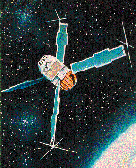The Uhuru Satellite Uhuru, also known as the Small Astronomical Satellite 1 (SAS-1) was the first earth-orbiting mission dedicated entirely to celestial X-ray astronomy. It was launched on 12 December 1970 from the San Marco platform in Kenya. December 12 was the seventh anniversary of the Kenyan independence and in recognition of the hospitality of the Kenyan people, the operating satellite was named Uhuru, which is the Swahili word for freedom. The mission operated over two years and ended in March 1973. Mission Characteristics
Photograph of Uhuru satellite courtesy of SAO.
Page authors: Lorella Angelini Jesse Allen HEASARC Home | Observatories | Archive | Calibration | Software | Tools | Students/Teachers/Public Last modified: Thursday, 24-Sep-2020 21:29:27 EDT HEASARC Staff Scientist Position - Applications are now being accepted for a Staff Scientist with significant experience and interest in the technical aspects of astrophysics research, to work in the High Energy Astrophysics Science Archive Research Center (HEASARC) at NASA Goddard Space Flight Center (GSFC) in Greenbelt, MD. Refer to the AAS Job register for full details. |

